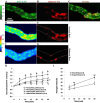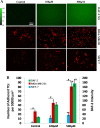Inhibition of endothelial nitric oxide synthase decreases breast cancer cell MDA-MB-231 adhesion to intact microvessels under physiological flows
- PMID: 27059076
- PMCID: PMC4935524
- DOI: 10.1152/ajpheart.00109.2016
Inhibition of endothelial nitric oxide synthase decreases breast cancer cell MDA-MB-231 adhesion to intact microvessels under physiological flows
Abstract
Nitric oxide (NO) at different concentrations may promote or inhibit tumor growth and metastasis under various conditions. To test the hypothesis that tumor cells prefer to adhere to the locations with a higher endothelial NO production in intact microvessels under physiological flows and to further test that inhibiting NO production decreases tumor cell adhesion, we used intravital fluorescence microscopy to measure NO production and tumor cell adhesion in postcapillary venules of rat mesentery under normal and reduced flow conditions, and in the presence of an endothelial nitric oxide synthase (eNOS) inhibitor, N(G)-monomethyl-l-arginine (l-NMMA). Rats (SD, 250-300 g) were anesthetized. A midline incision (∼2 inch) was made in the abdominal wall, and the mesentery was taken out from the abdominal cavity and spread over a coverslip for the measurement. An individual postcapillary venule (35-50 μm) was first loaded with 4,5-diaminofluorescein diacetate (DAF-2 DA), a fluorescent indictor for NO. Then the DAF-2 intensity was measured for 30 min under a normal or reduced flow velocity, with and without perfusion with MDA-MB-231 breast cancer cells, and in the presence of l-NMMA. We found that tumor cells prefer to adhere to the microvessel locations with a higher NO production such as curved portions. Inhibition of eNOS by l-NMMA attenuated the flow-induced NO production and reduced tumor cell adhesion. We also found that l-NMMA treatment for ∼40 min reduced microvessel permeability to albumin. Our results suggest that inhibition of eNOS is a good approach to preventing tumor cell adhesion to intact microvessels under physiological flows.
Keywords: NG-monomethyl-l-arginine; curved and straight portions; flow-induced nitric oxide production; microvessel permeability to albumin; postcapillary venule in rat mesentery.
Copyright © 2016 the American Physiological Society.
Figures










Similar articles
-
Endothelial surface glycocalyx can regulate flow-induced nitric oxide production in microvessels in vivo.PLoS One. 2015 Jan 9;10(1):e0117133. doi: 10.1371/journal.pone.0117133. eCollection 2015. PLoS One. 2015. PMID: 25575016 Free PMC article.
-
Adhesion of malignant mammary tumor cells MDA-MB-231 to microvessel wall increases microvascular permeability via degradation of endothelial surface glycocalyx.J Appl Physiol (1985). 2012 Oct;113(7):1141-53. doi: 10.1152/japplphysiol.00479.2012. Epub 2012 Aug 2. J Appl Physiol (1985). 2012. PMID: 22858626 Free PMC article.
-
Caveolin-1 scaffolding domain promotes leukocyte adhesion by reduced basal endothelial nitric oxide-mediated ICAM-1 phosphorylation in rat mesenteric venules.Am J Physiol Heart Circ Physiol. 2013 Nov 15;305(10):H1484-93. doi: 10.1152/ajpheart.00382.2013. Epub 2013 Sep 16. Am J Physiol Heart Circ Physiol. 2013. PMID: 24043249 Free PMC article.
-
Reinforcing endothelial junctions prevents microvessel permeability increase and tumor cell adhesion in microvessels in vivo.Sci Rep. 2015 Oct 28;5:15697. doi: 10.1038/srep15697. Sci Rep. 2015. PMID: 26507779 Free PMC article.
-
Improved measurements of intracellular nitric oxide in intact microvessels using 4,5-diaminofluorescein diacetate.Am J Physiol Heart Circ Physiol. 2011 Jul;301(1):H108-14. doi: 10.1152/ajpheart.00195.2011. Epub 2011 May 2. Am J Physiol Heart Circ Physiol. 2011. PMID: 21536843 Free PMC article.
Cited by
-
In Vivo Modulation of the Blood-Brain Barrier Permeability by Transcranial Direct Current Stimulation (tDCS).Ann Biomed Eng. 2020 Apr;48(4):1256-1270. doi: 10.1007/s10439-020-02447-7. Epub 2020 Jan 8. Ann Biomed Eng. 2020. PMID: 31916126 Free PMC article.
-
Interactions between Nitric Oxide and Hyaluronan Implicate the Migration of Breast Cancer Cells.Biomacromolecules. 2022 Sep 12;23(9):3621-3647. doi: 10.1021/acs.biomac.2c00545. Epub 2022 Aug 3. Biomacromolecules. 2022. PMID: 35921128 Free PMC article.
-
Glycocalyx Acts as a Central Player in the Development of Tumor Microenvironment by Extracellular Vesicles for Angiogenesis and Metastasis.Cancers (Basel). 2022 Nov 3;14(21):5415. doi: 10.3390/cancers14215415. Cancers (Basel). 2022. PMID: 36358833 Free PMC article. Review.
-
CDKN2A is a prognostic biomarker and correlated with immune infiltrates in hepatocellular carcinoma.Biosci Rep. 2021 Oct 29;41(10):BSR20211103. doi: 10.1042/BSR20211103. Biosci Rep. 2021. PMID: 34405225 Free PMC article.
-
Facile Synthesis of Hemin Derivatives with Modulated Aggregation Behaviour and Enhanced Nitric-Oxide Scavenging Properties as New Therapeutics for Breast Cancer.Small Sci. 2024 Jul 16;4(11):2400237. doi: 10.1002/smsc.202400237. eCollection 2024 Nov. Small Sci. 2024. PMID: 40213457 Free PMC article.
References
-
- Adamson RH, Liu B, Fry GN, Rubin LL, Curry FE. Microvascular permeability and number of tight junctions are modulated by cAMP. Am J Physiol Heart Circ Physiol 274: H1885–H1894, 1998. - PubMed
-
- Balligand JL, Feron O, Dessy C. eNOS activation by physical forces: from short-term regulation of contraction to chronic remodeling of cardiovascular tissues. Physiol Rev 89: 481–534, 2009. - PubMed
-
- Bates DO, Curry FE. Vascular endothelial growth factor increases hydraulic conductivity of isolated perfused microvessels. Am J Physiol Heart Circ Physiol 271: H2520–H2528, 1996. - PubMed
-
- Boo YC, Jo H. Flow-dependent regulation of endothelial nitric oxide synthase: role of protein kinases. Am J Physiol Cell Physiol 285: C499–C508, 2003. - PubMed
Publication types
MeSH terms
Substances
Grants and funding
LinkOut - more resources
Full Text Sources
Other Literature Sources
Medical
Miscellaneous

